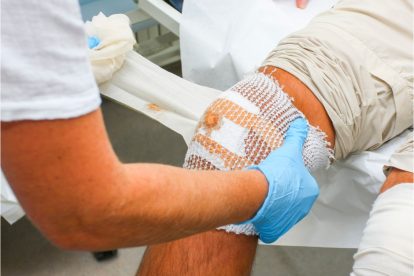Introduction
Wound care is a basic facet of healthcare that can dramatically affect person results. As we transition from classroom learning to professional technique, the significance of useful applications comes to be apparent. The journey of transforming theoretical knowledge into clinical know-how is paramount for healthcare specialists, specifically nurses, who often act as the very first line of protection in injury management.
In this thorough post, we check out the numerous dimensions of basic wound care training and its sensible applications in professional setups. Our discussion incorporates everything from foundational theories to specialized techniques, making certain that injury treatment specialists are outfitted with the needed abilities and expertise. We will delve deep right into subjects such as chronic wound care management, complex wound care strategies, and the role of nursing in efficient wound care management.
Understanding Injury Care Expert Training
What Is Injury Treatment Expert Training?
Wound care specialist training includes an area of education that prepares healthcare experts to efficiently take care of a range of injuries. This specialized training equips people with the skills necessary to assess, diagnose, and implement therapy prepare for people experiencing severe and chronic wounds.
Why Is Wound Care Training Important?
The relevance of wound care training can not be overstated. Properly educated professionals can minimize issues connected with wounds, enhance recovery times, and enhance overall person satisfaction. In addition, reliable wound monitoring minimizes medical care expenses related to long term healthcare facility keeps and added treatments.
Key Elements of Wound Treatment Expert Training
Assessment Techniques
- Learning how to do complete assessments is crucial. This consists of understanding the makeup of skin layers and recognizing indicators of infection.
Treatment Modalities
- Different kinds of wounds call for certain therapy strategies, including dressings, topical agents, and advanced therapies.
Patient Education
- Teaching patients concerning their wounds enhances conformity with therapy programs and advertises far better health and wellness outcomes.
Multidisciplinary Approach
- Effective wound administration commonly involves cooperation amongst doctor throughout different specialties.
Basic Wound Care Training for Nurses

What Does Basic Wound Care Training for Nurses Involve?
Basic wound care training for nurses concentrates on outfitting them with vital skills required to provide first evaluation and ideal monitoring for patients' wounds.
Core Subjects Covered in Basic Injury Care Training
- Anatomy & Physiology: Understanding skin structure is vital for recognizing regular healing processes. Types of Wounds: Distinguishing between intense injuries (like cuts or abrasions) and chronic wounds (such as stress abscess) is critical. Infection Control: Methods to prevent infections throughout clothing changes are shown rigorously. Dressing Selection: Selecting ideal dressings based on wound type affects recovery effectiveness.
Wound Care Training Courses Available
Types of Wound Care Training Courses
Numerous courses are available for those looking for sophisticated expertise in wound administration:
Introductory Courses- Designed for newbies that require fundamental knowledge.
- Focused on complicated cases calling for specialized abilities and knowledge.
- Many institutions offer online components that provide adaptability while keeping high educational standards.
Choosing the Right Course
When choosing a training course, consider elements such as accreditation, course content importance, duration, delivery technique (online or in-person), and cost.
Nursing Wound Care Training: A Foundation for Success
How Does Nursing Wound Care Training Prepare Professionals?
Nursing wound care training lays the groundwork needed for medical professionals to manage various scenarios they may experience in technique effectively.
Importance of Continual Education
With breakthroughs in clinical science continually advancing ideal practices in wound administration, recurring education and learning ensures that registered nurses stay competent in brand-new methods and technologies.
Practical Applications in Medical Settings
From Classroom to Clinic: Practical Applications of Fundamental Injury Treatment Training
Transitioning from theoretical frameworks discovered in class to real-world clinical applications needs diligent method and experience. For instance:
- Initial Patient Assessment: Utilizing assessment tools found out throughout training assists nurses precisely determine an individual's needs upon admission. Creating Therapy Plans: Recognizing various methods permits registered nurses to make individualized treatment plans tailored particularly to every person's special situation. Monitoring Progress: Nurses can use assessment techniques discovered during their training to keep track of recovery properly while making changes when required.
Chronic Wound Care Management
What Comprises Persistent Wounds?
Chronic injuries are defined as injuries that fail to proceed with typical stages of healing due to underlying problems such as diabetes mellitus or venous insufficiency.
Challenges in Persistent Wound Management
Managing chronic wounds offers numerous obstacles:
Identifying Hidden Causes Infection Avoidance Strategies Implementing Advanced DressingsSuccessful monitoring calls for both skillful nursing practices together with alternative patient factors to consider-- addressing psychological wellbeing alongside physical health concerns.
Complex Wound Care Strategies
What Are Complex Wounds?
Complex injuries often involve comorbidities that complicate basic therapy procedures-- instances consist of diabetic person foot ulcers or surgical website infections adhering to substantial surgeries.

Effective Methods for Taking care of Facility Cases
Interdisciplinary Collaboration- Working alongside medical professionals, dietitians, and physiotherapists can boost overall client outcomes.
- Techniques like negative stress therapy or bioengineered skin replacements might be presented based upon specific needs.
- Regularly taking another look at therapy strategies ensures interventions remain effective over time.
FAQs Concerning Standard Injury Treatment Training
1. What Prevail Sorts Of Wounds?
Common types include abrasions, lacerations, slit injuries, surgical lacerations, stress ulcers (bedsores), diabetic person foot ulcers, etc.
2. For how long Does It Take To Complete Basic Wound Treatment Training?
Most standard courses range from one day to a number of weeks relying on the institution's educational program framework yet commonly go for thorough protection within 20-- 40 hours basic wound care training complete instruction time separated over numerous sessions or intensive formats.
3. Can I Acquire Online Certification For Fundamental Wound Care?
Yes! Various accredited establishments now use on-line qualification courses tailored specifically toward fundamental principles surrounding efficient monitoring strategies utilized by healthcare providers today!
4. Is Continuing Education Required After Finishing First Training?
Yes! Continuous education and learning plays a vital role within lots of medical care careers-- it helps ensure practitioners remain updated pertaining to arising techniques connected straight back in the direction of enhancing patient outcomes!
5. Just how Do I Know If My Present Skills Are Sufficient For Taking Care Of Complex Cases?
Regular self-assessment paired along with feedback gotten from peers/mentors provides insights regarding areas needing renovation-- participating in correspondence course occasionally aids maintain understanding fresh too!
6. Exactly How Can I Remain Updated On Advances In The Area Of Wound Management?
Engaging with professional organizations concentrated around advancing methodologies/protocols within this specialized area together with subscribing journals associated directly back towards pertinent innovations help practitioners greatly!

Conclusion
Navigating the trip from classroom learning to clinical method requires commitment and dedication from medical care experts associated with basic wound care training programs. By understanding essential elements underpinning effective applications-- whether with analyzing diverse types/wounds precisely; applying evidence-based strategies tailored specifically toward private client requirements; focusing on continuous education opportunities offered-- the transformation into skilled practitioners comes to be not simply feasible however inevitable!
With ongoing efforts focused on sharpening capabilities additionally-- healthcare employees will undoubtedly enhance their duties sustaining optimum healing pathways while improving general quality-of-life experiences throughout populaces served!